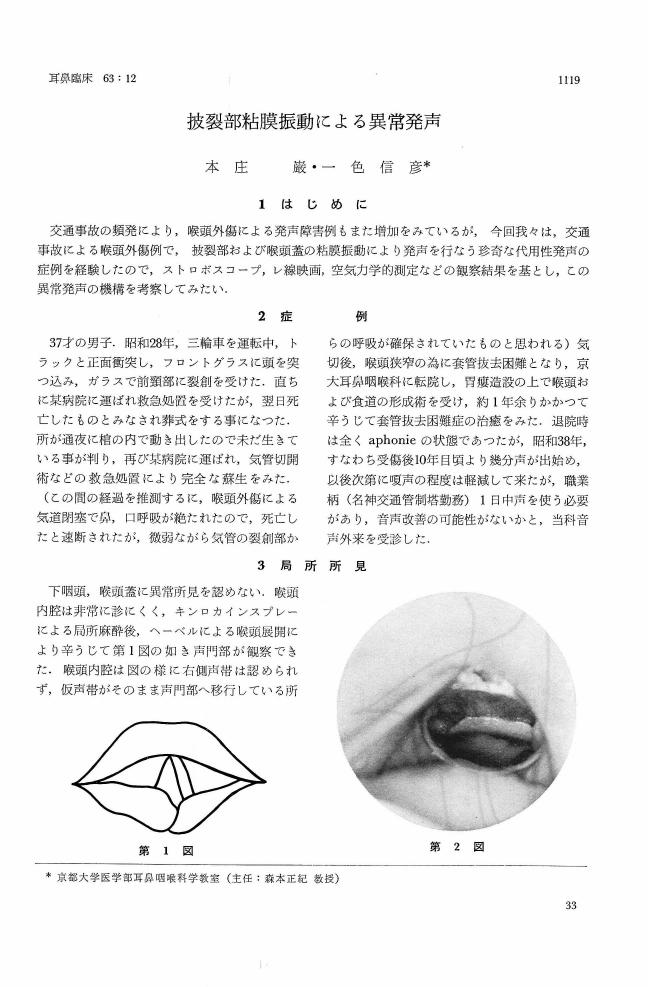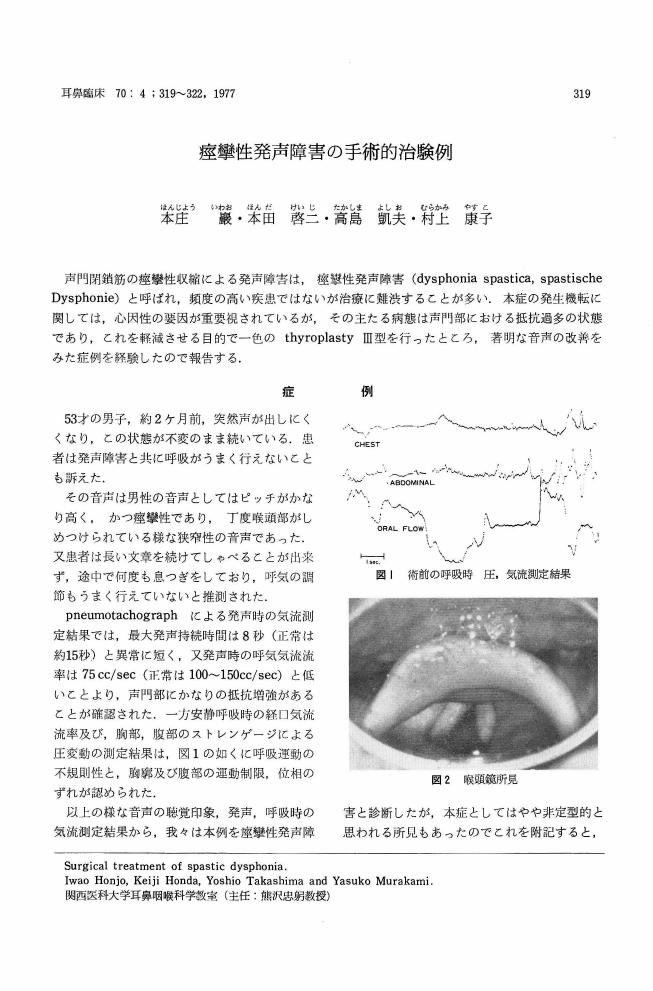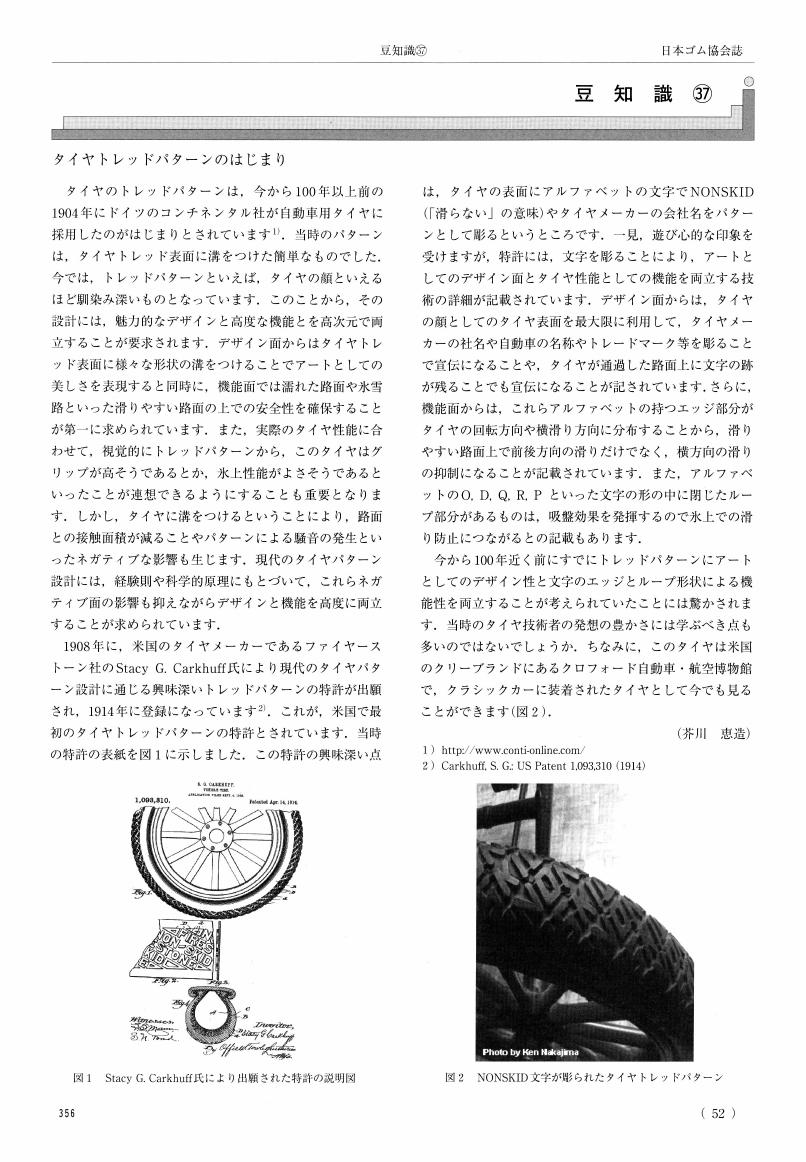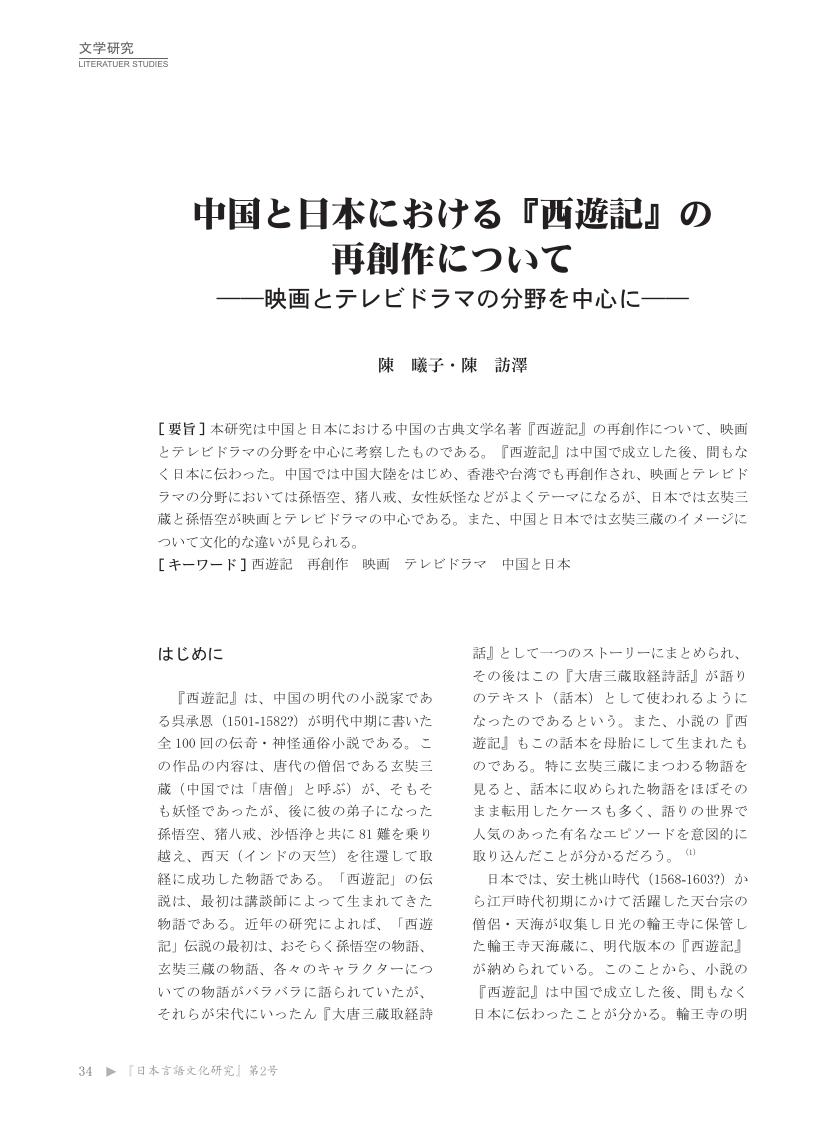1 0 0 0 OA 披裂部粘膜振動による異常発声
1 0 0 0 OA 痙攣性発声障害の手術的治験例
1 0 0 0 イスラーム時代の土製箱型香炉
- 著者
- シルクロード学研究センター編
- 出版者
- シルクロード学研究センター
- 巻号頁・発行日
- 2006
1 0 0 0 エジプトのイスラーム文様 : 暮らしの中に華開いた美しき意匠
- 著者
- Miho Museum編
- 出版者
- Miho Museum
- 巻号頁・発行日
- 2003
1 0 0 0 OA オオゴキブリ穿孔材の特性について
- 著者
- 伊藤 広記 大澤 直哉
- 出版者
- 日本森林学会
- 雑誌
- 日本森林学会大会発表データベース 第124回日本森林学会大会
- 巻号頁・発行日
- pp.69, 2013 (Released:2013-08-20)
オオゴキブリ(Panesthia angustipennis spadica)は大型の食材性ゴキブリで、本州北部から九州まで広く分布し、針葉樹及び広葉樹の朽木に穿孔することが知られている(朝比奈 1991)。しかし、野外における本種の生態に関しては不明な点が多く、生息環境を詳しく調べた例はほとんどない。特に生息場所兼食物である朽木の性質は明らかにされていない。演者らは、オオゴキブリが利用する朽木の性質を明らかにするため、京都市左京区の吉田山を調査地とし、2011年5月から2012年12月、林床の朽木(N=65)について、オオゴキブリ生息の有無、直径と長さ、樹種(針葉樹/広葉樹)、木材腐朽菌の種類(白色/褐色)、腐朽度を記録した。オオゴキブリが生息していた割合は、褐色腐朽が見られた朽木が白色腐朽が見られたものに比べ有意に高く、直径が大きい朽木が小さいものに比べ有意に高いことが示された。しかし、朽木の樹種、木材腐朽菌、腐朽度について、いずれの区分に属する朽木にもオオゴキブリの生息が確認され、本種が利用する朽木の種類や腐朽段階はかなり幅広いものと推測された。
- 著者
- 渡邉 正彦
- 出版者
- 至文堂
- 雑誌
- 国文学 : 解釈と鑑賞 (ISSN:03869911)
- 巻号頁・発行日
- vol.73, no.4, pp.13-18, 2008-04
1 0 0 0 OA 嚥下障害及び発声障害をきたした強直性脊椎骨増殖症の1例
- 著者
- 楊井 知紀 衛藤 正雄 朝長 匡 末廣 昌嗣 岩永 斉 進藤 裕幸 相良 耕三 吉田 省二
- 出版者
- West-Japanese Society of Orthopedics & Traumatology
- 雑誌
- 整形外科と災害外科 (ISSN:00371033)
- 巻号頁・発行日
- vol.49, no.2, pp.392-395, 2000-03-25 (Released:2010-02-25)
- 参考文献数
- 8
We experienced a case of dysphasia and dysphonia due to Ankylosing spinal hyperostosis (ASH) of the cervical spine.The patient was a 78-year-old man who was admitted to the department of internal medicine in our hospital for the examination and treatment of dysphasia and Mendelson syndrome. Dysphonia appeared later. X-rays of the cervical spine showed ossification of the anterior longitudinal ligament (OALL) at the C2 to C7 regions. The patient received surgical treatment.After the removal of OALL, dysphasia and dysphonia improved. The causes of these ASH symptom are examined in this study.
1 0 0 0 OA 贍部洲はインド亜大陸か 求法僧の記述を中心に
- 著者
- 八尾 史
- 出版者
- 対法雑誌刊行会
- 雑誌
- 対法雑誌 (ISSN:24355674)
- 巻号頁・発行日
- vol.3, pp.1-21, 2022 (Released:2022-08-01)
Modern scholars in the field of Buddhist studies have often regarded Jambudvīpa/ Jambūdvīpa, the semi-triangular continent located to the south of Mount Sumeru in Indian Buddhist cosmography, as representing nothing but India. Although this interpretation would be certainly correct within the context of Indian Buddhism, it might not be necessarily so outside this context. East Asian Buddhists, for example, are known to have traditionally included China in Jambūdvīpa. In this paper, I examine the usage of the name Jambūdvīpa in the writings of Chinese Buddhist monks who traveled to India, especially Xuanzang 玄奘 and Yijing 義淨 , and people close to the former. Through this examination, I would like to clarify how they related their geographical knowledge to the Indian Buddhist view of Jambūdvīpa. In his Datang xiyu ji 大唐西域記 Xuanzang provides a brief description of the world based on Abhidharma treatises, but he includes China in Jambūdvīpa, mentioning four kings who were said to reign in the four quarters of the continent. Moreover, deviating from the worldview of the Abhidharmakośabhāṣya he translated, he refers to Lake Anavatapta as the center of Jambūdvīpa, aligning the Indian notion of the continent with the reality that China and India are connected by land. Yijing’s Nanhai jigui neifa zhuan 南海寄歸内法傳 provides several examples where the author refers to land consisting of India, Indochina, China and several other regions by the name Jambūdvīpa. These accounts have been mistranslated by some modern scholars, who interpreted Jambūdvīpa as referring to only India. In the Datang daci’ensi sanzang fashi zhuan 大唐大慈恩寺三藏法師傳 , a biography of Xuanzang written by his disciples, there is a conversation between Xuanzang and monks of Nālandā in which Jambūdvīpa is mentioned twice. The four modern translations I was able to consult significantly differ from each other in their interpretations of this part of the text, and at least two of them seem to regard Jambūdvīpa as India contrasted with China. I offer an understanding different from these translations, pointing out quotations from the Vimalakīrtinirdeśa made in the conversation in question and suggesting that the biographer who wrote this part considered Jambūdvīpa to include both India and China.
1 0 0 0 OA 艦船造修60年のあゆみ : 東京第一工場の足跡
- 著者
- 城田 公治
- 出版者
- 公益社団法人 日本船舶海洋工学会
- 雑誌
- Techno marine 日本造船学会誌 (ISSN:09168699)
- 巻号頁・発行日
- vol.864, pp.99-103, 2001-11-10 (Released:2018-03-28)
1 0 0 0 OA 禅宗成立における民俗仏教との関係 正法寺本『辦道話』を手がかりに
- 著者
- 渡部 正英
- 出版者
- 駒沢宗教学研究会
- 雑誌
- 宗教学論集 (ISSN:03873323)
- 巻号頁・発行日
- vol.2016, no.35, pp.113-132, 2016 (Released:2021-04-17)
The Zen sect is based on the concept “Zazen,” which means “to sit in meditation.” It is said that it was introduced from China by Doushou( 道昭) in the Nara period. While Zen's important religious mission of saving people was introduced at that time, it first became a formal sect in the Kamakura period. This was only after Dougen (道元) wrote “Bendouwa,” a book with the purpose of spreading the Zen sect. Its contents describe in detail how he introduced Zen and its message was meant to be the answer to people's questions about life. In its early manuscript, the basis of the missionary work was to continue the practice of Zazen, which involved meditations inspired by the idea of Buddha ( 仏) praying for the dead (Hotoke) for whom people wished salvation. Dougen answered the people's questions and expectations of Buddhism with Zen. He showed it mainly through the practice of sitting in contemplation. The actual activity of the Zen sect was not established until Keizan's( 瑩山) missionary work.
1 0 0 0 OA 玄奘三藏のアビダルマ學の特相
- 著者
- 春日井 眞也
- 出版者
- Japanese Association of Indian and Buddhist Studies
- 雑誌
- 印度學佛教學研究 (ISSN:00194344)
- 巻号頁・発行日
- vol.1, no.2, pp.478-482, 1953-03-25 (Released:2010-03-12)
1 0 0 0 『鼻』--調和への志向 (特集 芥川竜之介作品の世界)
- 著者
- 高橋 竜夫
- 出版者
- 至文堂
- 雑誌
- 国文学解釈と鑑賞 (ISSN:03869911)
- 巻号頁・発行日
- vol.64, no.11, pp.35-38, 1999-11
1 0 0 0 OA 豆知識 (37)
- 著者
- 芥川 恵造
- 出版者
- 一般社団法人 日本ゴム協会
- 雑誌
- 日本ゴム協会誌 (ISSN:0029022X)
- 巻号頁・発行日
- vol.81, no.8, pp.356, 2008-08-15 (Released:2010-03-25)
- 著者
- 藏中 しのぶ
- 出版者
- 日本文学協会
- 雑誌
- 日本文学 (ISSN:03869903)
- 巻号頁・発行日
- vol.45, no.6, pp.61, 1996-06-10 (Released:2017-08-01)
1 0 0 0 OA 国際コミュニケーションとしての翻訳 -歴史的経験-
- 著者
- 箕輪 成男
- 出版者
- 国立研究開発法人 科学技術振興機構
- 雑誌
- 情報管理 (ISSN:00217298)
- 巻号頁・発行日
- vol.27, no.10, pp.869-881, 1985 (Released:2012-09-28)
- 参考文献数
- 20
異言語間のコミュニケーションは, 一方または双方がバイリンガルで, かつ当事者間に共通言語が存在する場合以外, 誰かバイリンガルな第三者の媒介を得なければ成立しない。そうした媒介に通訳と翻訳がある。実務的な通訳は二つの異なる民族が接触するとき, いつでも発生するのが, 高度な知的作業としての翻訳は, いつでも成立するわけではない。系統的翻訳事業が行われるのは, 民族が知的活性に富み, 外界から学ぶ姿勢を堅持する時代においてのみである。本稿では, 通訳から翻訳へという異言語間コミュニケーションの発展過程をたどった後, (1) 中世, (2) 近代への過渡期, (3) 現代, の三つの時代について, 翻訳出版の歴史的事実を分析する。最後に(1) 孤立国, (2) 国際化社会形成国, (3) 文化的従属国の三つのモデルを設定し, そこにおける国際コミュニケーションの態様と, その文化的含意を探る。
1 0 0 0 OA 中国と日本における『西遊記』の再創作について 映画とテレビドラマの分野を中心に
- 著者
- 陳 曦子 陳 訪澤
- 出版者
- アジア日本言語文化研究会
- 雑誌
- 日本言語文化研究 (ISSN:24346780)
- 巻号頁・発行日
- vol.2, pp.34, 2020 (Released:2021-08-18)
1 0 0 0 OA 「見えないもの」を見る力 —川端康成「金塊」の〈文脈〉—
- 著者
- 馬場 重行
- 出版者
- 日本文学協会
- 雑誌
- 日本文学 (ISSN:03869903)
- 巻号頁・発行日
- vol.60, no.8, pp.52-61, 2011-08-10 (Released:2017-05-19)
田中実氏が提示する「読むこと」の理論を基に、小説作品の〈文脈〉を読むとはいかなることか、その具体的なあり方を、川端康成の「金塊」を素材に考察したのが本稿である。その結果、戦争へと傾斜していく国家の「地下性」に潜む暴力を語り手が暴き出す「金塊」の問題点を指摘し、この作品の重要性、および教材価値について示唆することができた。
1 0 0 0 OA 般若と識の相違 (平成六年十月十二日 提出)
- 著者
- 平川 彰
- 出版者
- The Japan Academy
- 雑誌
- 日本學士院紀要 (ISSN:03880036)
- 巻号頁・発行日
- vol.50, no.1, pp.1-25, 1995 (Released:2007-06-22)
In my paper I discuss the difference between prajña and vijñana from various angles. Firstly, I examine Majjhima-nikaya No. 43, Mahavedalla-sutta, the sutta expounding the difference between prajña and vijñana. This sutta points out that prajña and vijñana exist within the same mind framework, at the same time; and act upon the same objects at the same time; however, they are different ways of understanding because prajña is‘to become aware of something’whereas vijñana is‘to recognize something by distinguishment, ’and thus, while prajna can be strengthened by training, our perception of vijñana must be re-examined.
1 0 0 0 OA 中央アジア仏教寺院における祠堂建築の空間構成の類型 礼拝対象物の配置に着目して
- 著者
- 中村 優花 岡﨑 甚幸
- 出版者
- 日本建築学会
- 雑誌
- 日本建築学会計画系論文集 (ISSN:13404210)
- 巻号頁・発行日
- vol.83, no.754, pp.2441-2451, 2018 (Released:2018-12-30)
- 参考文献数
- 88
This study is to analyze the types of spatial composition within Buddhist shrines. The focus was on the spatial composition, the plan forms and the arrangement of worship objects (stupas and Buddhist statues). This research is based on 55 documented Buddhist temples in Central Asia. The shrine architectures have been divided into 4 types based on spatial compositions. The meanings of spatial composition also have been discussed by conjecturing how worship acts were performed in shrine architectures. For the purpose of this study, Central Asia is defined as: northern Pakistan, Afghanistan, Uzbekistan, Tajikistan, Kyrgyzstan, Turkmenistan and Xinjiang Uyghur (Fig. 1). The plan forms were divided into the following types: single chamber, two-celled chamber which has main chamber and ante-chamber (having wing walls and without wing walls type), and the corridor type (a main chamber enclosed by a single wall/ two-celled chamber enclosed by a single wall) (Fig. 2). According to the classification of plan forms, the arrangement of worship objects was classified as I, II, III, and IV. The spatial compositions were analyzed based on the schemas. The shrine architectures have been divided into 4 types as the follows (Fig. 3): I. Worshippers face worship object inside or outside the chamber: Worshippers do not enter inside, and face to the worship object directly; Worshippers enter inside directly without wing walls, judging from its large scale; Worshippers enter inside through wing walls, judging from its large scale and the spatial composition. II. Shrine with axiality: the worship object is located at the further end of the shrine (in some cases, center of the shrine). There is the symbolic direction to the worship object. Worshippers face the worship object. III. Shrine with circumambulatory: the worship object is housed in the center of the main chamber. Accordingly, pradak?i?a (Buddhist devotional practice) is performed. IV. Shrine with centrality: the worship objects are placed on three sides or four sides of the main chamber. The plan forms of shrines are centralized plan such as a square and a cruciform. Axiality is a common characteristic in many shrine architectures. Axiality is necessarily component in the case of the two-celled chamber type shrines. In addition, it became clear that there is the shrine architecture includes some characteristics of spatial composition: axiality + circumambulatory, and axiality + circumambulatory + centrality. Over a long period of time, circumambulatory design was adopted for wide areas because it indicated the circumambulation ritual from left to right of the worship object. On the other hand, there were few examples of shrine architectures with centrality. It has been conjectured that centrality was a determinate factor judging from the aspect of geographical distribution. Based on the analysis, the meaning of the spatial compositions was considered. The conclusions are as follows: - Shrines with axiality means that the Buddhist world continues forward. - Shrines with circumambulatory were held for service of the cosmological Buddha. - Shrines with centrality had worshippers enclosed by the Buddhist world. It could be considered that “circumambulatory” and “centrality” is contrasting characteristics of spatial composition and suggests a change of meaning in the shrine architecture.
- 著者
- 蒲生 秀也
- 出版者
- 公益社団法人 応用物理学会
- 雑誌
- 応用物理 (ISSN:03698009)
- 巻号頁・発行日
- vol.25, no.11, pp.431-443, 1956-11-10 (Released:2009-02-20)
- 参考文献数
- 9
Since optical systems have distinctive features as compared to electical communication systems, some formulation should be prepared for the optical image in order to use it in information theory of optical systems. In this paper the following formula for the inten-sity distribution of the image by an optical system having a given aperture constant a in the absence of both aberration and defect in focussing is obtained by considering the nature of illumination, namely, coherence, partial coherence and incoherence; _??_ where I(y) is the intensity of the image at a point of coordinate y, T12 the phase coherence factor introduced by H. H. Hopkins etc., E(x) the complex transmission coefficient of the object and A(x) the complex amplitude of the incident waves at the object, and the integra-tion is taken over the object plane. The above expression has some interesting features; namely, the “intensity matrix” composed of the element anm mentioned above is a positve-definite Hermitian matrix, and the diagonal elements are given by the intensities sampled at every point of the image plane separated by the distance λ/2a, and the trace of the matrix or the sum of diagonal elements is equal to the total intensity integrated over the image plane. Since an Hermitian matrix can be reduced to diagonal form by a unitary transformation, the intensity distribution of the image can be expressed as _??_ where λ1, λ2……λn, ……are non-negative eigenvalues of the intensity matrix. In case of coherent illumination, only the first term of the above equation remains and all the other terms are zero, because the rank of the coherent intensity matrix is one, and its only non-vanishing eigenvalue is equal to the total intensity of the image. On the other hand, the rank of the incoherent intensity matrix is larger than the rank of any other coherent or partially coherent cases. The term of the largest eigenvalue in the above formulation may be especially important, because it will correspond to the coherent part of the image in case of partially coherent illumination. From the intensity matrix of the image obtained by uniform illumination of the object having uniform transmission coefficient, we may derive an interesting quantity, namely _??_ where λn is the n-th eigenvalue of the intensity matrix and I0 is the trace of the matrix. d is zero for the coherent illumination and becomes log N for the incoherent illumination, where N is the “degree of freedom” of the image of the area S, namely, N=4a2S/λ2. The value of d for partially coherent illumination is a posititve quantity smaller than log N. A quantity δ=(d0-d)/d0 may be regarded as a measure of the “degree of coherence” of the illumination, where d0=log N and δ is unity for the coherent case and zero for perfectly incoherent case. The sampling theorem for the intensity distribution is derived, and the relation between elements of intensity matrix and intensities sampled at every point separated by the dis-tance λ/4a is shown.







